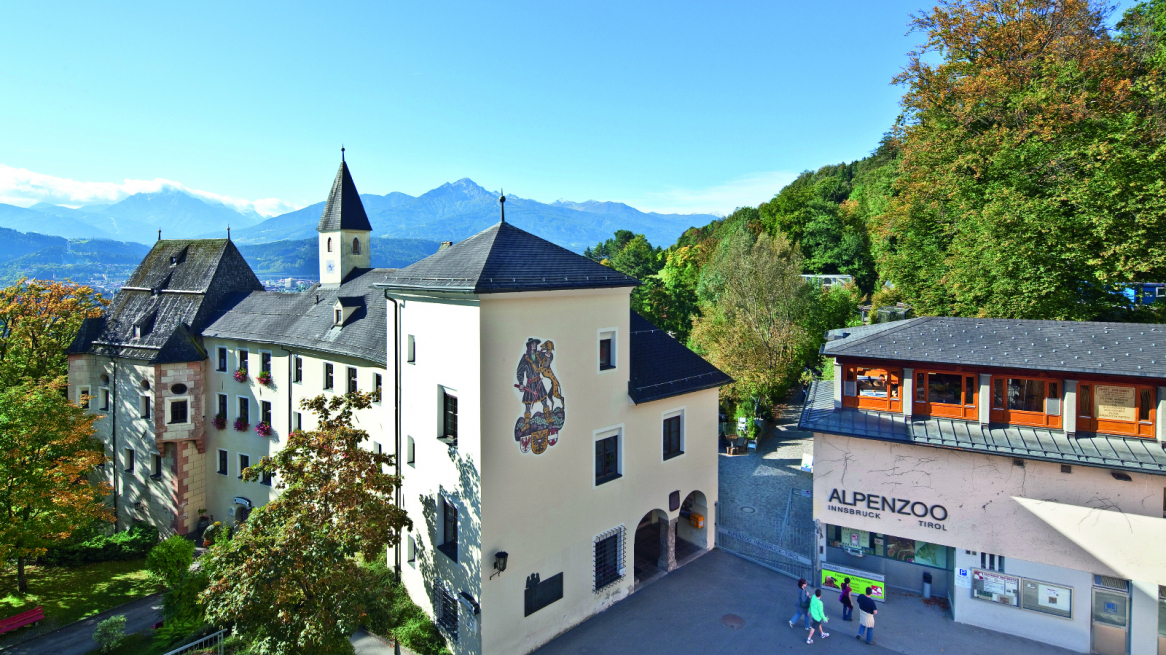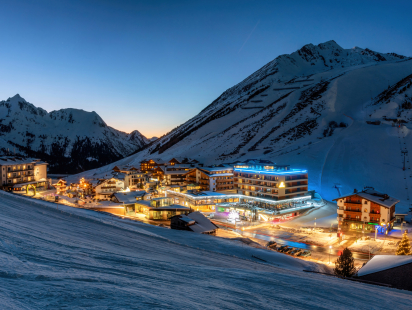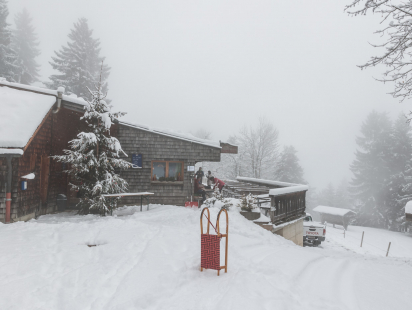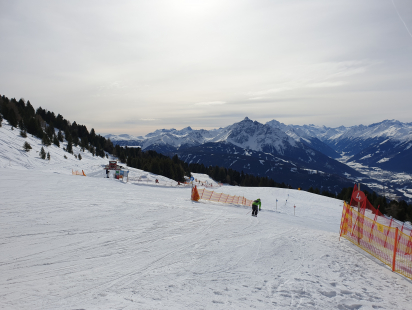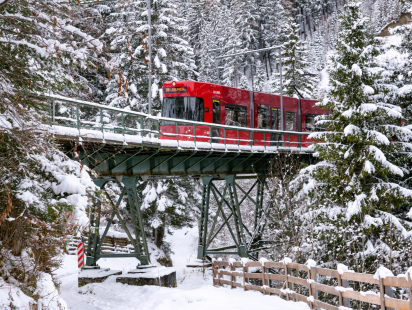In the olden days, zoos were established to entertain and impress. Decent contemporary zoos, however, emphasize their commitment to research, conservation and education. The Alpenzoo (Alpine Zoo) in Innsbruck was founded in 1962 by zoologist Hans Psenner with the vision of reintroducing endangered species into the wild, and it has since made invaluable contributions to this mission.

The entrance to the Alpenzoo, renewed in 2016, designed by local architect Helmut Reitter
Outstanding Status of the Alpenzoo:
- It is the only alpine-themed zoo in the world. It accommodates approximately 2000 Alpine animals of about 150 species.
- At 750 metres above sea level, it is the highest located zoo in Europe.
- It has the world’s largest cold water aquarium.

Sculptures capturing the spirit of Alpine animals
The Natural Setting is Impressively Convincing
The Alpenzoo is positioned in the elevated terrain of the Nordkette overlooking Innsbruck. Within the zoo grounds, the slope and difference in height is about 100 meters. It feels like a hillside garden blending into the forest. With elements such as water features, rocky slopes and hiding places, the enclosures are designed to emulate natural environments.

The view makes the aviary appear more spacious
There are several enclosures and aviaries where visitors can walk through. Please close the door behind you once you enter or leave!

Our blogger Danijel Jovanovic taking photos of the northern bald ibises
The Highlight in Spring: Adorable New-born Babies!
This year, the Alpenzoo has welcomed the offspring of lynxes, wildcats, ibexes and several other animals. Needless to say, it’s exciting for us to see them! Our blogger Danijel Jovanovic has featured the latest photographs in his article here (loaded with cuteness)!
After the babies are born, they firstly remain with their mother to be nursed.

The lynx family: the baby is safely tucked in the back
Have the youngsters been named?
In the Alpenzoo, animals are named after they have resided here for some time and are set to stay. For the ones who will move to other places, their names are left for their new hosts to decide.

Humans’ best friends? — A baby wildcat (wildkitten?) and a sunbathing wolf
Well-known Stars
Some well-known names in the Alpenzoo include Martina the brown bear (25 years old), Hero the 1000kg bison (19) and Attila the wolf (9). The other brown bear was also called Attilla before moving from Germany to Innsbruck, but has since been renamed “Ander“(6) — a name which can’t be more Tyrolean! The Alpenzoo received over 500 name suggestions for him from the public.

Ander’s movements are quite swift. (Martina’s fur is redder.)
Not only mammals are given a name. For example, Romeo and Julia are bearded vultures – how romantic! All 22 adult northern bald ibises are individually named, too.
Boosting the Wildlife Population
The Alpenzoo has carried out several programmes reintroducing Alpine animals back to the wild. The projects for ibexes, bearded vultures, northern bald ibises and black storks are great contributions. Even a European bison, the largest animal in Europe, has been relocated to a nature reserve in Romania. Among the ibexes born this spring, one pair will be released in the Zillertal area when they are ready. In addition, a rescued marmot was sent back to the wild recently.

An elk and a bison: bison always remind me of prehistory cave paintings

Once the babies are delivered, the male ibexes would stay away from the female and offspring to gradually establish a new hierarchy for the next breeding season.
Observation — Information
It might be obvious when mammals are expecting. How about those birds with their nests high up?
The zoo caretakers do check the nests for eggs with the help of a ladder, but the change in the birds’ behaviour is also a good indicator. For example, during breeding season, if a bird suddenly spends loads of time in the nest, it is likely that the bird is hatching eggs!

The golden eagle often gets very close to the visitors.

Unlike black storks, ibises live in a rocky and dry environment.
You might notice that the bearded vultures, the largest birds in the Alps, share their enclosure with seemingly defenseless marmots. Don’t worry! Bearded vultures are scavengers and not interested in finding live marmots on the menu. They mainly feed on bones in animal remains and have stomach acid of pH 1 to digest them.
Who are the eldest tenants in the Alpenzoö
Hint: They live in the aquarium and are over 70 years old.

The young students were really captivated by the creatures.

Left: skin shed by a snake

This ocellated lizard also shows signs of moulting.
Biological Clock
Many animals have their lunch served at noon and you will have a better chance to see them up close and in action then. As for nocturnal animals, some can be found sleeping in their beds. In winter, a few animals such as marmots do hibernate, but it might also mean you get to see other animals in snow!

Incredibly relaxed…. so cute
Inspirational Classrooms
There is also a petting area in the Alpenzoo. Farm animals are a staple of the rural scenes in Tyrol. Interacting with the animals is a heartwarming experience.

Let’s do this together!

“Nothing beats a nap in the mud, son.”

Friendly farm animals
For Non-German Speakers
There are maps available at the zoo entrance. The map is in German but there is a section listing the species in English and Italian. Actually, the animal icons and the enclosure numbers were sufficient for me to navigate. The signs and information boards are also in German, but the key information is mostly presented in a graphical way.

Their English name is in the second line.
How to Get There
Getting to the zoo by Hungerburgerbahn (Hungerburg funicular) could really compliment your “Alpenzoo experience”. After getting off at the Alpenzoo stop in the forest, take the elevator (or the staircase) down to the road. The zoo is then about 250 metres away and the walk is a bit uphill.

Funicular station designed by Zaha Hadid
City bus W, on the other hand, brings you almost directly to the door. Furthermore, the bus fare is a bargain!

“Europe’s Highest Positioned Zoo!”
If you have a valid Innsbruck Card, the rides and entrance to the Alpenzoo are covered.
It is also possible to walk from the city through the woods. The starting point is by the northern end of “Hans-Psenner-Steg (bridge)”.
Special thanks to Dipl. Biol. Dirk Ullrich, the curator of the Alpenzoo
I was fortunate enough to be accompanied by Mr. Ullrich to see the new-born animals. In this article, I hereby share what I’ve learned from him with you.

A head-bump greeting
All photos and video by Ichia Wu except the one at the top which is by TVB Innsbruck / Christof Lackner
Rate this article
Show me the location on the map
Ichia Wu is a Taiwanese artist with broad experience in the tourism sector. Since relocating to Innsbruck, she has become an ardent enthusiast of the traditional carnival celebrations ("Fasnacht") in Tyrol.
Similar articles
Who has experienced them, these clear, cold winter nights in the high mountains? Maybe even under a…
The toboggan run from the Rumer Alm is one of my absolute favorite toboggan runs. At just…
When I came to Austria at the age of 16, winter sports were still pretty exotic for…
Snow-covered forests, exercise in the fresh air, enjoying the winter... I am regularly drawn to go outside,…

